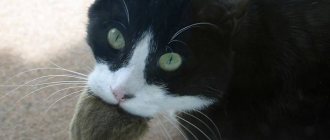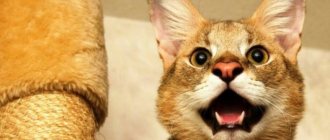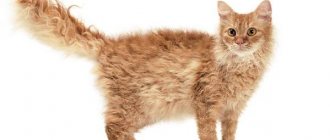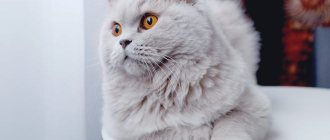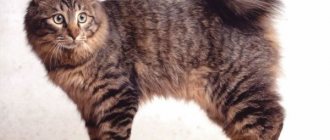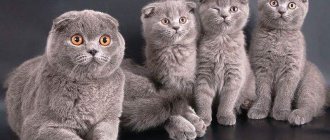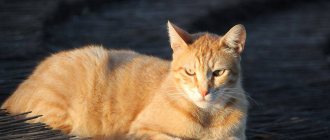Video
* We invite you to watch a video about the Kurilian Bobtail . In fact, in front of you is a playlist in which you can select and watch any of 20 videos about a given cat breed by simply clicking on the button in the upper right corner of the window. In addition, the material contains quite a lot of photos. By looking at them you can find out what the Kurilian Bobtail looks like.
Rate the material!
[Total votes: 2 Average: 5]
The Kurilian Bobtail is not a new breed, but has been reliably time-tested. Although it has become widespread only since the 90s of the last century, hundreds of nurseries in Russia and abroad are now engaged in it. Cats of this breed are friendly, have excellent health and good working qualities. They can be kept both in city apartments and in villages, where they adapt well to any natural conditions.
Catering
High-quality food for the Kuril Bobtail is the key to a long and healthy life. So remember:
- An adult animal is fed 2 times a day: in the mornings and evenings. You should wash the bowls once a day (do not use any detergents other than laundry soap) and pour clean water at a comfortable temperature into the drinking bowl every day. Kittens 2-5 months old are fed 3-6 times.
- Don't feed your cat from your table. Fatty soups, fried potatoes, chocolate and other favorite foods, unfortunately, are real poison for the animal. Sweet, salty, smoked, sour, canned, flour and baked goods are strictly prohibited.
Natural products
Important diet foods:
- Meat (beef, chicken, turkey, rabbit).
- Fish (both river and sea).
- Plant foods (zucchini, pumpkin, carrots, green salad, asparagus, broccoli, parsley, dill, beans).
- Chicken yolk (boiled), quail eggs.
- Porridge (rice, oatmeal, buckwheat, millet).
- By-products (liver, kidneys, ventricles, hearts).
- Dairy products cause metabolic disruption. The same applies to potatoes, baked goods, dog food, and human canned food. But sprouted oat grains for bobtails are one of their favorite treats.
The water should either be passed through a kitchen filter or left for a day in an open container.
Recommended food
When choosing dry food, buy only food from the holistic group. Applaws, Farmina N&D, Jaguar. Other foods are not suitable for Kurilian Bobtails.
Below are the recommended holistic class foods. Links with the names of the food are clickable, on them you can, within our website, get acquainted with the descriptions of the food and read reviews from owners of Kuril Bobtail cats.
| Holistic | Holistic | Super premium |
| Acana | Go Natural | Organix |
History of the origin of the Kuril Bobtail
The homeland of the Kuril Bobtail, as you might guess, is the Kuril Islands (specifically Kunashir and Iturup). At the end of the last century, this narrowly regional aboriginal breed began to spread in the wake of general interest in new breeds of pets. And joined other similar forms of short-tailed cats - bobtails.
Short-tailed mutations appear in different regions independently, and carriers of this interesting trait become the founders of breeds if they do not have disorders in their genotype that are dangerous to health. This is how a mutant cat once appeared in Japan. The Japanese, great lovers of curiosities, developed a breed of Japanese bobtails, which were brought to the Kuril Islands. Here, in alliance with local cats, they in turn gave birth to more massive and stocky Kurilian bobtails.
The breed was formed in the harsh natural conditions of the islands, with their cold, snowy winters, strong winds, and summer monsoon downpours. Cats have undergone natural selection for endurance and vitality, and in the struggle for existence they have acquired a calm character and excellent hunting skills.
The new breed received recognition only after the development of a standard by Moscow breeder O. Mironova and its acceptance by official organizations. The first breed standard was adopted by the Soviet Felinological Federation (SFF) in October 1991, the latest international standard in 2001. This breed was recognized by international felinological organizations in 1994.
The World Cat Federation (WCF) and the International Organization for the Breeding of New Breeds (FIFe) have approved two varieties of the Kurilian Bobtail depending on the length of their coat: semi-longhair and shorthair. At exhibitions, these forms are evaluated separately.
Kurilian Bobtail - description of the breed
A typical Kurilian bobtail is a hunter cat, whose appearance evokes clear associations with wild representatives of the cat tribe. But the sizes are not particularly impressive: the weight of the cat is 5-7 kg, and the female is even less - 4-5 kg.
Otherwise, a cat of this breed is characterized by:
- Strong, muscular and short body with a slightly arched back and high croup, which resembles a lynx;
- Strong legs, with the hind legs slightly longer than the front ones, and wide round paws;
- Proportional head with rounded triangular outlines;
- Round, dense cheeks and a strong chin;
- Small, spaced ears, rounded at the ends. Tassels are welcome;
- Straight wide nose;
- Eyes set wide apart and slightly slanted, usually yellowish-green in color;
- A tail of 2 - 10 vertebrae, bent in different directions or twisted in the form of a spiral, with a total length of 3 - 8 cm. Looks like a lush pom-pom, thanks to its especially long hair;
- The wool is thin and soft to the touch. In short-haired bobtails, it is correspondingly short on the body, although on the belly and back it is longer and forms “pants.” In semi-longhair - long or medium length, forms a collar and frill on the neck;
- Dense undercoat.
Faults that may cause a reduction in score or disqualification from a show include characteristics that are more common to other breeds and thereby make the boundaries between them blurred.
Disadvantages include:
- Lack of tail;
- A tail whose length is beyond the acceptable limits, as well as short and straight;
- Too massive or, conversely, light body;
- Excessively short front legs;
- Narrow and long head;
- Convex cheekbones;
- A long nose;
- Large and pointed ears;
- Round eyes;
- Lack of undercoat;
- Invalid color.
Popular colors of Kuril Bobtails
Kurils can be dressed very differently, although gray-brown striped, spotted and marbled outfits (tabbies), reminiscent of wild ancestors, or bicolors (bicolors) with large spots, like the classic “nobles,” are preferred. Red tabby and tri-color (tortoiseshell) colors are not uncommon. All black and all white specimens are allowed. Colors characteristic of the Abyssinian, Burmese, Thai, Siamese and similar breeds are considered defective.
Such as:
- Color point - with a light body and a dark muzzle, ears, tail and limbs, regardless of color;
- Smooth brown of all shades, for example, like Abyssinians;
- Lilac – the color of coffee with milk, of varying degrees of dilution;
- Cinnamon – cinnamon or light brown color;
- Fawn is a delicate beige color, smooth or with dark stripes and spots.
The color of cats is more a genetic concept than a visual one. For breeders, the combination of genes that determines color is more important than its external expression. For example, an Abyssinian cat, which anyone would call brown or red, is black from a genetic point of view. Because the color of her coat is determined by the gene responsible for the black color. But the red bobtail owes its color to another gene - red.
The white muzzle, chest, belly and “socks” on the paws are very characteristic of smokers. Moreover, on the hind limbs they can well be called “stockings”. Such details are acceptable for any color and pattern of the skin. The eye color should look nice in combination with the color; the most “universal” are green and yellow eyes. For white fluffies and bicolors with a large share of white in color (harlequin, van), sky blue eyes are ideal.
Character and habits of Kurilian Bobtails
Like any native breed, which was formed by uncontrollable conditions of the natural environment, and not by the comfort of a nursery, Kurbobs know how and love to hunt. As island residents, they have mastered fishing, are not afraid of water and are good swimmers. They know how to stand up for themselves when meeting an enemy, but in the house they are affectionate and playful, like any “couch” cats.
This breed easily adapts to new conditions, but is ideal for keeping in a country house, where cats can have fun with their original activities and stay fit. We must not forget that one of the main characteristics of the breed is well-developed muscles.
The Kuril Bobtail breed is considered intelligent. Kittens are inquisitive, active and easily learn all sorts of tricks. For example, they bring a thrown ball. It’s not for nothing that Kurilian Bobtails are said to be cats with a canine character. They become especially attached to the owner of the house, that is, to the one whom they themselves consider the owner. They can go fishing or hunting with him and accompany him on short hiking trips. But they also treat the other inhabitants of the house well, patiently enduring even the antics and noise of small children.
Interesting fact: Cats are friendly and get used to the company of dogs and other non-food animals. If a pair of Kurils of different sexes lives in a house, they form a strong family, remaining faithful to each other even during walks. But there are limits to everything and you shouldn’t try to make friends of these born hunters with birds and hamsters.
Kurbobs are child-loving, and not only their mothers, which would not be surprising. Cats of this breed love kittens no less and can take care of them, licking and playing with the cat. A commendable custom, given the brutal tendencies of most cats, who easily strangle kittens, even their own.
Types of bobtails
The bobtail cat breed is divided into several varieties.
American Bobtail
Unlike many of its counterparts, the American Bobtail cat breed has an official ancestor. It is generally accepted that he is a wild tabby kitten with a funny short tail, found on the territory of an Indian reservation (USA, Arizona).
This baby became the “ancestor” of the breed. American Bobtail cats are loving, good-natured and lovable creatures. These animals get along easily with other pets and are very loyal to children. In addition, they are very cheerful and active, they love fun games and walks in the fresh air. Cats quickly become attached to their owners and need love in return.
The American Bobtail does not tolerate loneliness, so you should not leave your pet alone for a long time.
This is a cat of quite large size, with a short, mobile tail and a well-developed muscular body.
Breed characteristics:
- The body is moderately long, stocky, strong;
- the back is straight, has slightly protruding shoulder blades;
- the chest is wide and deep;
- the head is wedge-shaped, the forehead is convex;
- the muzzle is wide, almost square, with slightly protruding cheekbones, the nose is medium in size; chin well developed, slightly rounded;
- ears are set wide apart, tilted forward, and have medium length;
- the eyes are slightly slanted, almond-shaped or oval, set wide apart;
- the neck is strong, of medium length, with sufficiently developed muscles;
- The limbs are heavy, short, and muscular. The front ones are somewhat shorter than the rear ones;
- paws are round, large with tufts of hair between the toes;
- the tail is very mobile, short, and looks like a shaving brush or brush.
The animal has thick fur , which needs careful care, especially during the molting period.
The American Bobtail comes in a variety of colors, the most popular of which is hare. The weight of the animal is from 3 to 8 kg.
The American cat exists in two varieties - shorthair and semi-longhair. The former have a short, springy coat with a moderately developed soft undercoat. Semi-long-haired individuals have sweaty, shaggy, medium-length fur with a soft undercoat. The decorative hair on the croup, hind legs, chest and neck is slightly longer than the main coat. The color can be any.
Japanese Bobtail
In its homeland, this cat is a symbol of friendship ; its images can often be found in Japanese paintings and engravings dating back to various historical periods. The breed is considered a native of the Far East and is widespread in Korea and China, where it symbolizes success, prosperity and well-being. The breed is quite popular in the States, but is not widely known in the UK.
Breed characteristics:
- The Japanese Shorthair cat has a slender, well-built body of medium size;
- the body is muscular, strong, the same width along the entire length, oblong;
- the lower back and back are slightly convex, the shoulders are broad;
- limbs are slender, long, the forelimbs are shorter than the hind limbs, slightly bent at rest;
- the tail is vertical, short (5-7 cm, but can reach up to 12 cm), in appearance it resembles a pompom, similar to a hare. There is a fur edge at the base of the tail;
- head shape - triangular;
- the eyes are oval, large, giving a charming expression to the animal’s face;
- The coat is close to the body, short, and there is almost no undercoat. The color is usually tortoiseshell and white, but other shades are also found. Tricolor (white, red and black with a predominance of the first) is valued most highly.
The Bobtail is distinguished by its good nature and calmness . The cat prefers company, is very smart, curious, understanding, endlessly devoted to its owner and, according to breeders, can swim, hunt well and even fetch game. The breed is characterized by different eye colors: one is yellow, the other is blue. Small kittens with this feature are especially valuable.
The average weight of an adult cat is 3.5 kg, males - up to 5 kg.
The life expectancy of Japanese bobtails is quite high, they have good health and are practically not susceptible to any illnesses.
Kurilian Bobtail - photo
This is a breed of tailless cats, originating from the indigenous inhabitants of the Kuril Islands - short-tailed cats. The Kurilian Bobtail is our Russian, rather young breed, similar in appearance to a lynx .
And with its heroic character and independence it resembles a wild animal, but thanks to its loyalty, kindness and endless tenderness, the bobtail is recognized as a domestic cat. Unlike the widely known and long-recognized Japanese Bobtail throughout the world, the Kuril cat breed appeared relatively recently - at the end of the 20th century. This is how a cat with excellent qualities as a rat catcher and hunter lived on the Kuril Islands, delighted the local residents with his wonderful character and did not have any troubles. And then it turned out that this was not just a tailless animal, but a natural Russian miracle, at the sight of which cat lovers all over the world expressed genuine delight. One after another, Kurilian bobtails won victories at cat shows in Europe: in Italy, Germany, Poland, and the Czech Republic.
The main difference between Kuril cats and Japanese cats is their special unique charm and “purely Russian facial expression,” which successfully combines canine devotion and the truly brutal look of the “master of the taiga.”
Kurilian Bobtail - description of the breed:
- The coat is very beautiful and rich, of medium length;
- ears with tassels;
- the body is strong and powerful;
- the forelimbs are clearly lower than the hind limbs, which is why the gait becomes playful and special;
- the tail is small, shortened: everted and twisted. It is almost impossible to find the same pair of tails; these, one might say, are their “fingerprints”, individual for each individual.
These inhabitants of the Kuril Islands are quite successful in the fight against rats , so they are reputed to be excellent rat catchers. Bobtails have no difficulty coping with even large rodents; in addition, they dig out rat holes with their powerful forelimbs, getting out the offspring. But even after exterminating rodents, cats do not calm down and find an equally “fun” activity - chasing a mosquito or a fly, and for them cockroaches are pure entertainment.
Another distinctive feature of Kurilian Bobtails is their ability to fish. The animals have ears slightly tilted forward, which can be folded so that water does not get inside, so bobtails can easily dive under water and catch fish.
These cute creatures have dog-like habits and are distinguished by their trainability, courage, sociability, intelligence and loyalty. Cats follow their owners everywhere, spending the night on their legs, knees, or right on their owner’s bed.
As a rule, Kuril cats prefer to choose only one “object of adoration” from among the family members, and are simply friendly towards the rest.
Features of Kuril Bobtails:
- coexist quite peacefully with dogs;
- hypoallergenic;
- prefer constancy and do not change their location;
- get along well with children.
Even if your child constantly cuddles the Kuril cat, she will nobly endure all the torment and will not show any aggression. Since the Kurilian Bobtail is more dog-like in character, it is very wary of the appearance of strangers and promptly warns of dangers.
Today the breed is quite popular and is constantly updated. You can buy a Kuril Bobtail kitten in one of the many nurseries in Russia, Ukraine and Belarus. The price depends on the pedigree of the Kuril cat, the prestige of the nursery, the color and class of the animal.
Diseases of the Kuril Bobtail
Bobtails, including Kuril ones, have excellent health and strong immunity, however, just like cats of other breeds, they can get sick with any of the diseases characteristic of the entire cat family.
Thai Bobtail
This species is truly a legend in the cat world. According to legend, the ancestors of the Thai Bobtail protected princesses. The animals have a dark, short tail, as well as paws and a muzzle of the same color. The loops and lines on the tail are individual for each individual. Just like all bobtails, Thai cats have dog-like habits and love to carry various objects in their teeth.
Fluffies are overly curious and very attached to their owner. By nature, they are cute and friendly animals who love to “chat.” However, “Thais” are very restrained in their emotions and try not to express them. Only males are involved in raising children. It is the “men” who lick their offspring and teach the kids etiquette and “good manners”.
The weight of a cat is on average 2.3 kg, cats are slightly larger - up to 4 kg.
Interesting facts about Kurilian Bobtails
The tail of any Kuril Bobtail is unique, and when breeding, breeders do not try to achieve uniformity.
There are 4 main types:
- “Stump” - vertebrae number 2-8, very short and closely packed together, the tail is motionless and knobby thickenings - fractures - can be felt on it;
- "Broom" is a more common "model". The vertebrae are connected in a zigzag at obtuse angles to each other. Relatively mobile;
- “Spiral” is a highly deformed tail in which the vertebrae are located at all sorts of angles, even sharp ones. Usually has the shape of a spiral or hook that curves over the back or is adjacent to the sacrum. In places the joints are movable and the cat can even wag its tail;
- “Retracted bobtail” is the same spiral, but located at the end of a straight section of 5-7 vertebrae. The tail is usually relatively long and is considered a defect that reduces show scores.
The first cat to be officially registered as a representative of the new breed was named Chip-O, and the first champion was Ai-ok-a-Kuna. The fact is that at first felinologists did not distinguish the bobtails brought from the Kuril Islands from the already known Japanese ones, so they gave them such exotic names.
Kurbob fans believe that their favorites are able to recognize about 1.5 thousand words and understand individual phrases. By the way, my “yard guy” also perfectly understands several phrases, especially with unprintable words.
The sporting achievements of seals of this breed include the ability to catch fish weighing up to 5 kg, the ability to cope with a powerful rat and jumping to a height of up to 2 m.
Kurbobs are very talkative, and the range of sounds they make is extremely wide. In addition to the banal meowing and yelling during a fight, they can grumble, chirp, and whine like a dog. They usually voice all their actions, especially disgustingly and loudly reporting the discomfort they experience. For example, sitting on your hands.
Pros and cons of Kurilian Bobtails
When you decide to get a pet, you need to find out its needs and behavioral characteristics in advance. This will save you from unnecessary problems. What can you say about Kurilian Bobtails?
The advantages of the breed include:
- Easy adaptability;
- Quick wit and quick learner;
- Activity and playfulness;
- Friendliness, including towards dogs;
- Contact and social loyalty, for example, towards strangers;
- The fact that there is no need for frequent combing of the coat;
- Weak expression of molting;
- Lack of special food preferences;
- Good health (if you choose the right kitten);
- Hunting talent.
Depending on who keeps them and where, the benefits can turn into their opposite. Thus, activity and playfulness in an apartment can damage order and disturb the owner, who is busy with business or simply sick. Moreover, many cats are loud, even loud. Not everyone has time to maintain the vigorous physical condition of a pet, play with it and walk it, take it to the country or just for a country picnic.
Interesting fact: Another problem with apartment living is falling out of a window, which can lead to a cat’s hunting excitement, jumping up at the sight of flying game. Therefore, in the apartment where the bobtail lives, bars on the windows are necessary.
Devotion to the owner obliges the latter not to part with the pet for a long time, who will miss him. Separations do not improve the character of the animal, and it can run wild, become capricious and angry. For those who leave home for a long time, it is better to get a cat of a different breed, one that is not so affectionate. Particular difficulties arise for breeders of Kurils.
How to choose a kitten
Purchasing a Kurilian Bobtail kitten is a responsible step that requires intuition and attentiveness from you! It is important to notice among the frolicking kittens exactly the one who will catch your heart. At the same time, you should not listen to either the words of the breeder or the advice of friends and relatives: this is your pet, so you only need to rely on your own premonitions.
The ideal age for purchasing a Kurilian Bobtail is three months. It is at this time that the baby begins to show independence and gradually weanses the habit of maternal care. In addition, a three-month-old “smoker” already has fairly balanced psychological health, so he quickly gets used to new family members.
If the pedigree of the future pet plays an important role, ask the breeder to introduce you to the necessary documentation or, more preferably, to the parents of the babies. This is one of the easiest ways to understand what to expect from your bobtail. The breeder is not talkative and does not demonstrate a desire to tell as much as possible about his charges? This is an alarming sign: it means he has something to hide from curious and persistent buyers like you.
When choosing a kitten, you should focus on its behavior among its brothers. Is your baby active and cheerful, happily getting involved in play and showing healthy curiosity towards you? This is your pet! Refrain from buying lethargic and timid kittens: this may lead to unpleasant consequences in the future.
Breeding Kurilian Bobtails
Crossing Kurbobs with other breeds is prohibited in order to preserve their originality. Only purebred cats, that is, those with documents, are allowed for breeding. As felinologists say: “No documents - no breed.” The offspring of such parents can receive the status of purebred, but whether they will receive permission to breed or be relegated to the “pet” class, experts at exhibitions will decide.
An exception is made for cats brought directly from the Kuril Islands, Sakhalin and Kamchatka - they are issued a pedigree certificate at an exhibition in the “novice” class after the approval of experts and confirmation of the origin with a whole bunch of certificates. These include a veterinary passport, a transport ticket, photo and video materials proving that the applicant’s parents live in the listed regions.
The breed cannot be called widespread and the reason for this is low fertility. There are usually only 2-3 kittens in a litter. The maximum number - 5 can be obtained with successful selection of partners. The initially low population size led to inbreeding - that is, inbreeding, in which hereditary defects spread. Therefore, it is not uncommon for kittens to be born with defects: excessively short-tailed or tailless, with a coat structure that does not meet the standard.
Interesting fact: Deviations from the standard also appeared thanks to unscrupulous breeders who mated with cats of other breeds and introduced foreign genes into the gene pool of the breed. Therefore, when selecting pairs, a careful study of pedigrees is required.
But basically, breeders have to rely on luck, since the genetics of Kurbobs is poorly studied and genetic laboratories carry out only individual tests (for example, for the presence of an amber “carnelian” color).
It is known that a cat with a “stump” often produces tailless kittens. The tails of the “spiral” are well inherited. It is difficult to predict the results of mating cats with “brooms” and “retracted bobtails”. Bobtails live up to 20 years, which, however, is typical for cats in general. Breeding involves individuals from 2 to 10 years old.
Breeding
The Kurilian Bobtail cat often faces the problem of selecting a mate, since there are many individuals who have gaps in their biography. There are many people who do this, but they are not in all cities of the country.
Mating and pregnancy
Pregnancy lasts about 65 days, in some cases it can be up to 70. Before mating, it is necessary to vaccinate animals in advance and treat them against helminths. During this period, the cat needs to strengthen its nutrition - increase the portion and frequency.
Red Kurilian Bobtail.
Caring for Kurilian Bobtails
Kurbob is naturally healthy and if it has no birth defects, it does not require specific care. All the basic rules of keeping that are suitable for any cat are also suitable for him.
First of all, you need to arrange places for him to rest, eat and toilet and keep them clean. A scratching post is also a necessary piece of furniture in a cat owner’s home. Nowadays there are entire sets of houses and various cat utensils on sale, but the cat is not interested in issues of design and fashion, so he will not appreciate the cost of such luxury.
There is an opinion that cats need to be washed, but many people dispute it with furious persistence. We can assume that free-range kurbobs do not wash in bodies of water. Despite the fact that the breed's history includes fishing, a pet unaccustomed to water will greet washing with a scandal. It is logical to let them decide on their own issues of cleaning fur, ears, trimming nails and other hygiene. The fur of the semi-longhaired variety can be combed, and only during the spring molting period.
It is more important to monitor your pet's health. At a minimum, carry out annual comprehensive vaccination against viral diseases and rabies. Not only for walking cats, but also for those that do not leave the apartment, because the infection can be brought from the street on clothes and shoes. For the same reason, once or twice a year it is necessary to deworm domestic cats, and, of course, free-roaming ones.
Education and training classes are not considered mandatory for a cat, but the Kurilian Bobtail will be very happy if you pay attention to it. In addition, training the pet to commands such as “lie down”, “place”, etc. will make it easier to manage. And this is a great achievement in relations with such an animal as a cat.
Education and training
The Kurilian Bobtail breed has a developed intelligence; according to some studies, they can understand up to 1000 human words. Raising your pet correctly will not be difficult; he will easily learn to follow simple commands from his owner. For the cat to understand what not to do, it is enough to tell it in a stern voice, without the use of physical force or shouting. A stern word will stop the cat and prevent unwanted consequences.
At a certain age, the animal begins to test the boundaries of what is permitted, trying to take a leading position in its territory. The owner must respond to this adequately, making it clear that it is the person who is in charge in the house. This breed is also highly trainable, mainly due to its inquisitive mind and curiosity. Learning new tricks will be interesting for them; they will perceive the process itself as a new educational game.
Tips for raising bobtails
Cats of any breed, including the Kurilian Bobtail, do not tolerate aggression - physical and psychological. The peculiarity of smokers is their ability, in response to this, to begin to play pranks more intensely in the apartment.
How to train to the tray
Tray training is usually carried out by the breeder. Here, from birth, a kitten receives the skills necessary to live with a person. If a kitten comes to its owner without such knowledge, litter box training occurs within one introduction to the toilet. Usually one such session is enough.
Diet of Kurilian Bobtails
The diet of kurbobs has no special features in comparison with, say, nobles. Two types of nutrition are also possible for them: natural food and ready-made food. There is no convincing evidence that one type or the other is superior. It all depends on the preferences and beliefs of the owner.
In any case, the diet must be balanced, that is, it must provide the animal with all nutrients and vitamins, be well absorbed and not cause metabolic disorders. With natural feeding, the cat should receive a sufficient amount of meat and sea fish, but always with vegetables or porridge. Some experts do not advise giving this breed milk and potatoes, although there are as many opinions as there are specialists.
Interesting fact: Ready-made food is convenient because it is prepared by cat nutritionists and takes into account their different needs: gender, age, activity. Dietary and medicinal food options that take into account health problems are especially convenient. But in any case, you will have to go through a lot of brands before you find the right one for your animal.
The most convenient option that will suit everyone is a free-roaming cat that is looking for its own prey. But even in this case, it will have to be fed either natural or dried. So that he knows that he is loved. Additives for hair removal are not relevant in the case of kurbobs. Whether it is worth giving them all sorts of treats for cleaning their teeth or vitamins, everyone decides for themselves.
The fact that the food is complete and to the pet’s taste can be judged by the shine and fluffiness of its skin, cheerful mood and activity. When cleaning the tray, it is worth looking into it and assessing the results of feeding: the stool should not be liquefied or too dry. Traces of blood indicate a variety of problems in the body: from cystitis to worms and more serious diseases.
Care and maintenance of short-tailed Kuril cats
Bobtails cannot be called a capricious and finicky breed. But even in the case of a Kuril cat, you will have to pay attention to several care procedures. Following simple rules will help maintain not only the neat appearance of your pet, but also its health.
- Grooming
. The Kurilian Bobtail has thick and relatively long fur. However, the fur coat of clean island cats practically does not get dirty. It is recommended to comb short-tailed smokers several times a week, using a mitten or a soft brush. Although these cats love water, it is best to bathe them as needed.
- Feeding
. The bobtail cat is a born hunter, so its diet should be as natural as possible. Experts do not recommend feeding your cat exclusively fillet. The diet should include dry food, chicken or fish, and tough meat. Cats should get all the proteins, minerals and vitamins they need from their food to stay healthy.
global $ads_google; //data-ad-slot=”2475549904″ $ads_google = empty($ads_google) ? false : true; ?> if ($ads_google == false) {?> $ads_google = true; ?> } ?>
What to feed a Kurilian Bobtail kitten for 2 months
Diseases of Kurilian Bobtails
The development of the Kuril Bobtail breed occurred naturally. In this regard, the bobtail still holds the brand of a strong and healthy cat.
The Kuril cat is a long-liver, the average life expectancy of a short-tailed pet is 15–20 years.
However, as a bobtail ages, its excellent health can be disrupted by problems with the eyes, urinary tract, or irregular bowel movements. Timely visits to the veterinarian and routine vaccinations will help avoid serious diseases.
Diseases and health problems
Due to an abnormality of the tail or some other reason, smokers are characterized by inflammation of the anus, hemorrhoids and even prolapse of the rectum. This intimate area needs regular supervision from an early age. If cracks and redness appear, the butt is lubricated with vegetable oil or appropriate veterinary preparations, but the main thing is to reconsider the pet’s diet. Because the cause of the problem may be indigestion. Or worms.
A common disease in cats, especially sedentary domestic cats, is urolithiasis (UCD). Kurilian Bobtails have naturally more acidic urine than other breeds and their UCD is usually of the acidic type. But it is possible to determine exactly what dietary food they need when signs of illness appear after conducting an acidity test. However, there are foods for mixed type urolithiasis.
Advanced KSD often leads to kidney disease, which requires feeding with appropriate food. But for detailed consultations and gaining experience, it is always better to contact a specialist, in this case a veterinarian. The basis for this should be any violation in the pet’s behavior - physical or mental.
Preventive vaccinations against infectious diseases will protect pets from many diseases: viral, including rabies, and skin diseases. Preventive examinations are useful, during which it is useful to check the condition of teeth and vision, which is especially important for older cats - 10 years or more. In general, kurbobs are quite resilient and do not have specific genetic diseases. At least those that have been identified.
Care, maintenance and nutrition
Caring for the Kurilian Bobtail:
1. Since the fur of Kuril Bobtails has a lot of unique properties, these animals need to be bathed no more than once a month, and there is no need to comb them at all.
2. Nail trimming is also not worth doing. It is enough to install a scratching post in the house and the animal itself will put its claws in order.
3. It is important to monitor the condition of the cat’s teeth and cleanliness of the cat’s eyes and ears.
4. Periodically you need to take a damp cloth or swab and wipe the animal’s eyes.
What to feed Kurilian Bobtails:
1. The Kurilian Bobtail is a native cat breed and it is advisable to feed it as if it were in its natural habitat. His diet should include: meat, sea fish, healthy vegetables and even herbs.
2. Food must be balanced and contain a maximum of vitamins and minerals.
3. But dairy products are contraindicated for bobtails.
4. It is not advisable to mix natural and artificial food during one particular feeding.
